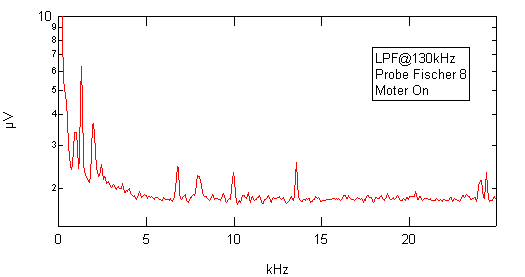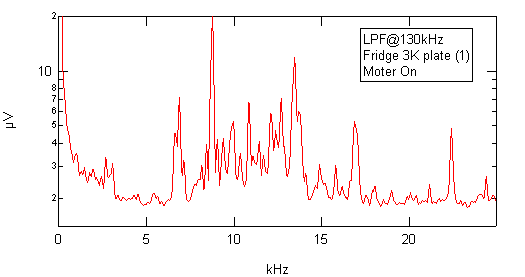You are here: Foswiki>QED Web>QedLabStuff>VectorFieldFridge>VectorFieldFridgeProbe1ColdFinger2Noise (20 Mar 2017, MatthewRendell)Edit Attach
VectorFieldFridgeProbe1ColdFinger2Noise
The noise on the DC wirings of the Probe was measured with Standford SR760 FFT Spectrum Analyzer. 130kHz LPF on the Standford rack is used to get rid of the self oscillation of the Spectrum Analyzer.Noise on the probe
Lemo pin 18 was measured, which is connected to the empty pin on the LCC20 package through semi-rigid CuNi coax. For comparison, Pin 8 connects to shielded twisted pairs: The Fischer connector on the breakout box connects 24 DC wires which go to the 50mK plate. All the wires are floating at 50mK and showed similar noise. Pin 8 is used. The Remote motor to the Fridge was turned on and off to identify the source of the noise.


 The noise performance of the loom (on the fischer connector) is much better than the CuNi coax (on the lemo). The noise on the coax may be due to the CuNi coax itself or the connectors at the 50mK stage.
The noise performance of the loom (on the fischer connector) is much better than the CuNi coax (on the lemo). The noise on the coax may be due to the CuNi coax itself or the connectors at the 50mK stage.
Noise in the Fridge
The pins of the thermometers on the cold plates inside the fridge were measured.


 Inside the fridge, there is no coax. The wires connected to the thermometers could be the same wires on the probe. The noise could be due to the connectors.
Inside the fridge, there is no coax. The wires connected to the thermometers could be the same wires on the probe. The noise could be due to the connectors.
Effect of LPF
The FFT spectrum will give self resonance if high frequency signals are sent in. So LPF is used with cutoff at 130kHz.

Current noise measurements - March 2017
The current noise was also measured on the DC probe wiring. Setup was:- Femto current preamp @ 10^7 V/A gain (50KHz bandwidth)
- SIM910 voltage preamp @ 10V/V gain with floating outer to break the ground loop
- SIM965 LPF @ 100KHz, 48dB bessel filter
- Oscilliscope measuring noise for 1 sec (full bandwidth mode)
 Pin 25 - PhBr flex coax (same as pins 26 and 27)
Pin 25 - PhBr flex coax (same as pins 26 and 27)
 Pin 28 - HF flex coax
Pin 28 - HF flex coax

Access Control
This page is open to the whole world to view.Tags
Comments
| I | Attachment | Action | Size | Date | Who | Comment |
|---|---|---|---|---|---|---|
| |
Fischer-Off.png | manage | 3 K | 06 Nov 2014 - 08:27 | RoyLi | |
| |
Fischer-On.png | manage | 3 K | 06 Nov 2014 - 08:27 | RoyLi | |
| |
Fridge-3K.png | manage | 3 K | 06 Nov 2014 - 08:27 | RoyLi | |
| |
Fridge-50mK.png | manage | 3 K | 06 Nov 2014 - 08:27 | RoyLi | |
| |
Fridge-Still.png | manage | 4 K | 06 Nov 2014 - 08:27 | RoyLi | |
| |
Fridge-mc.png | manage | 3 K | 06 Nov 2014 - 08:27 | RoyLi | |
| |
LPF-full.png | manage | 2 K | 06 Nov 2014 - 08:27 | RoyLi | |
| |
Lemo-Off.png | manage | 3 K | 06 Nov 2014 - 08:27 | RoyLi | |
| |
Lemo-On.png | manage | 3 K | 06 Nov 2014 - 08:27 | RoyLi | |
| |
NoLPF.png | manage | 3 K | 06 Nov 2014 - 08:28 | RoyLi | |
| |
Pin21_current_noise.png | manage | 86 K | 20 Mar 2017 - 09:05 | MatthewRendell | |
| |
Pin_25_current_noise.png | manage | 76 K | 20 Mar 2017 - 09:05 | MatthewRendell | |
| |
Pin_28_current_noise.png | manage | 76 K | 20 Mar 2017 - 09:05 | MatthewRendell |
Edit | Attach | Print version | History: r6 < r5 < r4 < r3 | Backlinks | View wiki text | Edit wiki text | More topic actions
Topic revision: r6 - 20 Mar 2017, MatthewRendell
 Copyright © by the contributing authors. All material on this collaboration platform is the property of the contributing authors.
Copyright © by the contributing authors. All material on this collaboration platform is the property of the contributing authors. Ideas, requests, problems regarding Foswiki? Send feedback


